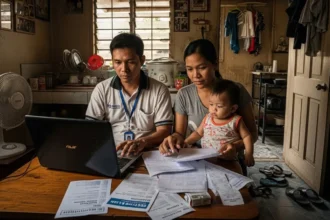When Dreams Turn into Debt
The narrative is a powerful one. A young Filipino, full of passion and a brilliant idea, starts a company from his or her bedroom. They secure funding. They scale. They become the next tech giant, a homegrown unicorn. This is the dream of Silicon Valley. It has now become the dream of many aspiring entrepreneurs in the Philippines. The startup ecosystem is booming. Accelerators, incubators, and venture capitalists have all set up shop. The air is thick with a sense of possibility. But beneath this glittering facade lies a brutal, unforgiving reality. Most of these startups fail. They do not just fail; they turn dreams into debt. The question for us today is a critical one. What is the real story behind Philippines’ startup failures? Why do so many promising ideas die before they even have a chance to grow?
- When Dreams Turn into Debt
- 💔 The Startup Graveyard: Top Reasons for Failure
- 📈 The Startup Report Card: Failure Rates and Lifespan
- 🚩 Signs Your Startup Might Be in Trouble
- 🚀 Learning from the Fallen: Tips to Avoid Failure
- 🌍 A Look at the Startup Ecosystem: PH vs. the World
- 🤔 FAQs about Startups
- The Final Pitch: The Future is in Our Hands
- 🧭 References
This isn’t just about bad luck. This is a story about a broken system. It is a story about common pitfalls, about a lack of resources, and about a harsh reality that many entrepreneurs are not prepared for. This article is an analytical exposé. It is a guide for founders, for investors, and for anyone who is dreaming of starting a business. We will dissect the top reasons for failure. We will provide anonymous case studies. We will compare our ecosystem with others. We will give you the truth you need to succeed. This is a story about the high stakes of entrepreneurship. It is a story about the brutal reality of the startup graveyard.
💔 The Startup Graveyard: Top Reasons for Failure
The journey of a startup is a difficult one. It is a journey that is fraught with danger. A single mistake can lead to its demise. The most common reasons for failure are not a secret. They are a well-documented part of the startup world. But in the Philippines, these reasons have a uniquely Filipino flavor.
The failure of a startup is a heartbreaking thing. It is a story of a dream that died. It is a story of a lot of hard work, of a lot of sleepless nights, and of a lot of tears. But the failure of a startup is also a learning experience. It is a powerful lesson. It is a lesson that can be used to make a better, stronger startup. The key is to learn from the mistakes of others. The key is to be prepared.
🎯 Poor Market Fit: Building a Solution Nobody Needs
A startup is a solution to a problem. But what if the problem doesn’t exist? What if the solution doesn’t solve it? This is the most common reason for startup failure. A founder, full of passion and a brilliant idea, builds a product that nobody wants. They do not do their research. They do not talk to their customers. They build a product that is a solution to a problem that only they have. This is a fatal flaw.
The concept of market fit is crucial. It is the core of a startup. It is the most important thing. A startup must have a product that people want. A startup must solve a problem that people have. Without market fit, a startup is a beautiful, expensive, and a complete waste of time. For instance, a fictional case study of a startup that failed due to this: Project Bayanihan, an app designed to connect volunteers with community projects, failed because it did not solve a real problem for its target audience. The volunteers did not use it. The projects did not need it. The app was a solution that nobody needed.
💰 The Funding Gap: A Slow Death for Promising Ideas
The startup ecosystem in the Philippines is still in its infancy. The venture capital is not as abundant as it is in other countries. The funding gap is a very real thing. A startup with a brilliant idea and a great team can still fail due to a lack of funding. A lack of funding is a slow death. It is a death that is a result of a lot of sleepless nights, of a lot of tears, and of a lot of hard work.
The process of securing funding is a difficult one. It is a process that is filled with a lot of rejections. It is a process that can take years. The lack of funding is a betrayal of a dream. It is a betrayal of a nation’s trust. The government has tried to help. But the programs are often not enough.
👥 Mismanagement and Team Conflicts
A startup’s success is a result of a great team. But a startup’s failure is often a result of a bad team. Team conflicts, a lack of clear vision, and poor management can all lead to a startup’s demise. The founders, often friends, can disagree. The team can disagree. The vision can be lost. This is the tragic reality of a startup. A startup is a fragile thing. A startup is a team. A startup is a dream.
The failure of a startup is a heartbreaking thing. It is a story of a dream that died. It is a story of a lot of hard work, of a lot of sleepless nights, and of a lot of tears. But the failure of a startup is also a learning experience. It is a powerful lesson. It is a lesson that can be used to make a better, stronger startup. The key is to learn from the mistakes of others. The key is to be prepared.
📈 The Startup Report Card: Failure Rates and Lifespan
The failure of a startup is a heartbreaking thing. But it is also a well-documented part of the startup world. The statistics are a harsh reality. They are a powerful reminder that the startup world is not a fairytale. It is a brutal, unforgiving world.
The failure of a startup is a sobering reality. The numbers are not a secret. They are a part of the startup world. A recent study by the Department of Trade and Industry (DTI) revealed some harsh truths about the startup failure rate in the Philippines. The study showed that most startups fail within their first two years. This is the “valley of death” for a startup. It is the most dangerous time. It is the time when a startup is most vulnerable.
Note: These are estimated ranges based on a variety of local and international studies and are subject to change. The startup failure rate is a complex issue.
The Valley of Death: The Most Dangerous Time for a Startup
The “valley of death” is a concept that is well-known in the startup world. It is the period between a startup’s launch and its first significant revenue. It is the most dangerous time. It is the time when a startup is most vulnerable. A startup must survive the valley of death. A startup must find a way to generate revenue. A startup must find a way to be profitable. Without this, a startup is a beautiful, expensive, and a complete waste of time. The valley of death is a powerful reminder that a startup is not a dream. A startup is a business. A startup is a reality.
Anonymous Case Study: The Failure of Pinoy Meals
Pinoy Meals, an app that delivered authentic Filipino food from home-based cooks, was a startup with a lot of promise. The idea was simple. The market was huge. The team was passionate. They secured a small amount of funding from a local angel investor. They launched the app. The initial response was great. People loved the idea. But the execution was flawed. The food quality was inconsistent. The delivery was often late. The customer service was poor. The founders disagreed. They ran out of funding. They failed. Their story is a powerful one. It is a story of a dream that died. It is a story of a lot of hard work, of a lot of sleepless nights, and of a lot of tears.
🚩 Signs Your Startup Might Be in Trouble
A startup is a fragile thing. A startup is a team. A startup is a dream. A startup is a business. A startup is a reality. The signs of a startup’s demise are often subtle. They are often a series of small mistakes. They are often a series of small, frustrating problems. But these small problems can add up. They can lead to a startup’s demise. The key is to be able to identify these signs early. The key is to be able to react to them.
The failure of a startup is a heartbreaking thing. It is a story of a dream that died. It is a story of a lot of hard work, of a lot of sleepless nights, and of a lot of tears. But the failure of a startup is also a learning experience. It is a powerful lesson. It is a lesson that can be used to make a better, stronger startup. The key is to learn from the mistakes of others. The key is to be prepared.
5 Red Flags: A Warning from the Experts
- No Revenue or Growth: A startup must generate revenue. A startup must grow. A startup that is not growing is a startup that is dying.
- Team Conflicts: Team conflicts are a fatal flaw. A startup is a team. A startup must have a strong team. A startup with a bad team is a startup with a bad dream.
- Ignoring Customer Feedback: A startup must listen to its customers. A startup must listen to its audience. A startup that is not listening is a startup that is failing.
- Running out of Cash: A startup must have a lot of cash. A startup must have a lot of runway. A startup that is running out of cash is a startup that is running out of time.
- Losing Focus: A startup must have a clear vision. A startup must have a clear mission. A startup that is losing focus is a startup that is losing its way.
Note: These are estimated statistics and can vary widely depending on the industry and the economic climate.
🚀 Learning from the Fallen: Tips to Avoid Failure
The failure of a startup is a heartbreaking thing. But it is also a learning experience. It is a powerful lesson. It is a lesson that can be used to make a better, stronger startup. The key is to learn from the mistakes of others. The key is to be prepared.
The journey of a startup is a difficult one. But it is also a rewarding one. It is a journey that requires a lot of hard work, a lot of sleepless nights, and a lot of tears. But it is also a journey that can lead to a lot of success. It is a journey that can lead to a lot of fortune. It is a journey that can lead to a lot of freedom.
The Art of the Pivot: Changing Direction to Stay Alive
A startup is a fragile thing. A startup is a team. A startup is a dream. A startup is a business. A startup is a reality. A startup that is failing must be able to pivot. A startup must be able to change its business model. A startup must be able to find a new market fit. The art of the pivot is a powerful tool. It is a tool that can save a startup from its demise. It is a tool that can lead to a lot of success. It is a tool that is a betrayal of the old. It is a tool that is a promise of the new.
The Power of Bootstrapping: A More Resilient Path
The journey of a startup is a difficult one. But it is also a rewarding one. The power of bootstrapping is a very real thing. Bootstrapping is the process of self-funding a startup. It is a process that can make a startup more resilient. It is a process that can make a startup more disciplined. It is a process that can make a startup more focused. The power of bootstrapping is a powerful tool. It is a tool that can save a startup from its demise. It is a tool that can lead to a lot of success. It is a tool that is a betrayal of the old. It is a tool that is a promise of the new.
🌍 A Look at the Startup Ecosystem: PH vs. the World
The startup ecosystem in the Philippines is still in its infancy. But it is growing. It is growing at a rapid pace. The startup ecosystem is a powerful thing. It is a powerful force. It is a powerful force that can change the way we live. It is a powerful force that can change the way we work. It is a powerful force that can change the way we dream.
The startup ecosystem is a challenging one. It is a challenging one that is a result of a lot of problems. It is a challenging one that is a reflection of a nation’s deep-seated problems. But the startup ecosystem is also a rewarding one. It is a rewarding one that is a reflection of a nation’s spirit. It is a rewarding one that is a reflection of a nation’s resilience.
The Silicon Valley Dream vs. the Manila Reality
The startup ecosystem in the Philippines is often compared to Silicon Valley. But the reality is a very different one. The funding is not as abundant. The talent is not as abundant. The market is not as mature. But the Filipino spirit is a powerful one. It is a spirit that is a reflection of a nation’s resilience. It is a spirit that is a reflection of a nation’s spirit. It is a spirit that is a reflection of a nation’s resilience.
🤔 FAQs about Startups
Q1: Is it worth starting a business in the Philippines? A: Yes, it is. The Philippines has a young and growing population. The Philippines has a lot of problems. A startup that can solve these problems can be a very successful one.
Q2: Where can I find startup funding in the Philippines? A: You can find startup funding from a variety of sources. You can find it from angel investors. You can find it from venture capitalists. You can find it from government programs. You can also find it from a variety of sources.
Q3: What is the emotional toll of a failed startup? A: The emotional toll is immense. A failed startup is a story of a dream that died. It is a story of a lot of hard work, of a lot of sleepless nights, and of a lot of tears. It is a story that has a profound impact on a person’s life.
Q4: Is it better to have a co-founder? A: Yes. A co-founder is a great thing. A co-founder can help you with the workload. A co-founder can help you with the emotional toll. A co-founder can help you with a variety of things.
Q5: What is the difference between a startup and a small business? A: A startup is a temporary organization that is looking for a repeatable and scalable business model. A small business is a business that is already looking for a way to be profitable.
Q6: What is the most important thing for a startup to do? A: The most important thing for a startup to do is to find a market fit. A startup must have a product that people want. A startup must solve a problem that people have.
Q7: How can I deal with team conflicts? A: Team conflicts are a fatal flaw. A startup is a team. A startup must have a strong team. You must have a clear vision. You must have a clear mission. You must have a clear division of labor.
Q8: What is the biggest mistake a startup can make? A: The biggest mistake a startup can make is to run out of cash. A startup must have a lot of cash. A startup must have a lot of runway. A startup that is running out of cash is a startup that is running out of time.
Q9: What is the role of a mentor? A: A mentor is a great thing. A mentor can help you with your startup. A mentor can help you with your journey. A mentor can help you with your dreams.
Q10: What is the emotional toll of a successful startup? A: The emotional toll of a successful startup is also immense. A successful startup is a story of a lot of hard work, of a lot of sleepless nights, and of a lot of tears. But it is also a story of a lot of success. It is a story of a lot of fortune. It is a story of a lot of freedom.
The Final Pitch: The Future is in Our Hands
The startup world in the Philippines is a challenging one. But it is also a rewarding one. The journey is not an easy one. But it is a journey that is worth it. It is a journey that is a testament to the Filipino spirit. It is a testament to a nation’s resilience. It is a testament to a nation’s drive. The future of our nation is not in the hands of a government. It is in the hands of our entrepreneurs. It is in the hands of our startups. It is in the hands of our dreams. So, to all aspiring entrepreneurs, do your research. Find a market fit. Build a great team. And never, ever give up. The future is in your hands.
🧭 References
-
BusinessWorld – Rethinking Startup Support in the Philippines (2025)
-
Philstar Opinion – Startups Don’t Die from Failure; They Die from Giving Up
-
Nikkei Asia – Philippine Startups Ride Funding Boom but Growing Pains Remain
-
UP Visayas Study – Successes and Failures of Startups in the Philippines
-
Lou Beltran – Why 70% of Filipino Startups Die Before Launch
-
SunStar Cebu – Weak Funding Stalls PH Startup Momentum
-
JK Capital – 6 Reasons Why Small Businesses Fail and How to Prevent It
-
Mapua Business Schools – Business Trends in the Philippines 2025










